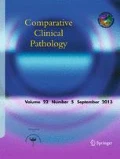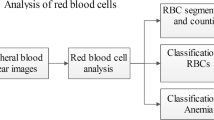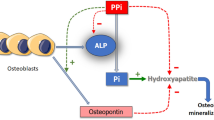Abstract
Canine diabetes mellitus is a multifactorial disease with a worldwide prevalence of 0.005 to 1.5%, affecting dogs between 4 and 14 years of age, males and females. Persistent fasting hyperglycemia and glycosuria confirm the diagnosis, and glycated hemoglobin (A1C) is an efficient biomarker for the risk of complications and monitoring. The scarcity of unvalidated reference values and commercial kits justifies its low application in veterinary medicine. The aim of this study was to identify A1C as a diagnostic biomarker of diabetes mellitus in dogs through immunoturbidimetry assay and to propose an A1C reference range for diabetic and nondiabetic dogs. We randomly selected 86 healthy dogs and 20 diabetic dogs of different ages and breeds, both male and female, neutered and not neutered. Hemogram, urea, creatinine, alanine aminotransferase, alkaline phosphatase, glycemia, and glycated hemoglobin were performed using the turbidimetry assay. The Spearman correlation test between A1C and the biochemical and hematological variables, ROC curve to analyze the diagnostic capacity of glucose, and A1C to predict diabetes in dogs was used. We obtained a median of 3.8% for A1C with a confidence interval of 3.8 to 4.0% for nondiabetic dogs and a cut off of 4.5% for diabetic dogs. Spearman’s correlation showed a direct relationship between A1C and glucose and a statistically significant association with glucose (p < 0.001) and creatinine (p < 0.002). The areas of the ROC curve of A1C and glucose had good indices in their individual use, and their association showed a positive and statistically significant correlation (p = 0.051). The diagnostic ability of A1C to predict diabetes mellitus in dogs was confirmed and A1C reference range established for nondiabetic and diabetic dogs, also showing association with creatinine, given this relevant and unprecedented data in the veterinary literature.



Similar content being viewed by others
References
Abdallah AM, Alves BCA, Gehrke FS, Santana AVL, Azzalis LA, Junqueira VB et al (2015) Inability of turbidimetry method in detecting glycated hemoglobin to select diabetes mellitus patients according to their concentrations of blood glucose levels. J Clin Lab Anal 29:312–316
Adin AC, Gilor C (2017) The diabetic dog as a translational model dog human islet transplantation. Yale J Biol Med 90(3):509–515
Allison RW (2007) Laboratory evaluation of the pancreas and glucose metabolism. In: Thrall MA (ed) Veterinary hematology and clinical chemistry. 2ª ed. Roca, Oklahoma, pp 433–435
American Diabetes Association [Internet homepage]. Classification and diagnosis of diabetes. Standards of medical care in diabetes [updated in January 2018] Jan;41(Suppl 1):S13-S27. Available in: http://care.diabetesjournals.org/content/39/Supplement_1/S13.full-text.pdf
Behrend E, Holford A, Lathan P, Rucinsky R, Schulman R (2018) 2018 AAHA diabetes management guidelines for dogs and cats. J Am Anim Hosp Assoc 54(1):1–21
Beltrame OC. Standardization of the methodology for determination of blood concentrations of glycated hemoglobin and fructosamine in healthy, diabetic dogs and under insulin therapy. [Dissertation] [internet] Curitiba:2011 [cited Oct03 2011]. Available in: URI https://acervodigital.ufpr.br/handle/1884/26165
Beltrame OC, Dittrich RL, Laskoski LM, Patricio LFL, Medeiros NC, Koch MO (2015) Reference values of glycated hemoglobin and fructosamine in dogs. Cien Anim Bras 16(n 4):548–552
Cook KA (2012) Monitoring methods for dogs and cats with diabetes mellitus. J Diab Sci Technol 6(3):491–495
Goemans AF, Spence SJ, Ramsey IK (2017) Validation and determination of a reference interval for canine HbA1C using an immunoturbidimetric assay. J Vet Clin Pathol 46(2):227–237
Marca MC, Loste A (2000) Glycosylated haemoglobin assay of canine blood samples. J Sm Anim Prac 41:189–192
Marca MC, Loste A, Unzueta A, Blood PM (2000a) Glycated hemoglobin evaluation in sick dogs. Can J Vet Res 64(2):141–144
Marca MC, Loste A, Ramos JJ (2000b) Effect of acute hyperglicemia on the serum fructosamine and blood glycated haemoglobin concentrations in canine samples. Vet Res Commun 24(1):11–16
Martorelli CR, Kogika MM, Caragelasco DS (2018) Diabetic nephropathy in dogs: literature review. Journal of Continuing Education in Animal Science of CRMV-SP. São Paulo:Regional Council of Veterinary Medicine 16(1):30–37
Nelson RW (1997) Diabete melito. In: Ettinger SJ, Feldman EC (eds) Internal veterinary medicine, 1ª edn. Manole, Rio de Janeiro, pp 2085–2122
Nelson RW, Reusch CE (2014) Animals models of disease. Classification and etiology of diabetes in dogs and cats. J Endocrinol 222(3):T1–T9
Netto AP, Bezerra MGT, Sumita MN. Update on glycated hemoglobin (A1C) for evaluation and glycemic control and for the diagnosis of Diabetes 2018: clinical and laboratory aspects. Positioning official Brazilian Society of Diabetes, Brazilian Society of Clinical Pathology, Brazilian Society of Endocrinology and Metabology and National Federation of Diabetes Associations and Entities. [Update 2017]; Available in: http://www.diabetes.org.br/publico/images/banners/posicionamento-3-2.pdf
Oikonomidis IL, Tsouloufi TKT, Soubasis N, Konstantinou MK (2018) Validation, reference intervals and overlap performance of a new commercially available automated capillary electrophoresis assay for the determination of the major fraction of glycated haemoglobin (HbA1C) in dogs. Vet J Elsevier 234:48–54
Põppl AG, Elizeire MB (2015) Diabetes mellitus in dogs. In: Dogs and cats internal veterinary medicine.1ª ed. Roca, Rio de Janeiro, pp 1747–1761
Põppl AG, Carvalho CLG, Vivian IF, Corbellini LG, González FHD (2017) Canine diabetes mellitus risk factors. A matched case-control study. Res Vet Sci 114:469–473
Rohlfing LC, Wiedmeyer MH, Little RR, England DJ, Tennil A, Goldstein DE (2002) Defining the relationship between plasma glucose and HbA1C. Diabetes Care 25(2):275–278
Author information
Authors and Affiliations
Corresponding author
Ethics declarations
Ethical approval
All applicable international, national, and/or institutional guidelines for the care and use of animals were followed.
Conflict of interest
The authors declare that they have no conflicts of interest.
Additional information
Publisher’s note
Springer Nature remains neutral with regard to jurisdictional claims in published maps and institutional affiliations.
Rights and permissions
About this article
Cite this article
Flohr, B.A.L., Maifrino, L.B., da Costa Aguiar Alves, B. et al. Use of the turbidimetric method for determining hemoglobin (A1C) in diabetic and nondiabetic dogs. Comp Clin Pathol 28, 1087–1094 (2019). https://doi.org/10.1007/s00580-019-02932-z
Received:
Accepted:
Published:
Issue Date:
DOI: https://doi.org/10.1007/s00580-019-02932-z




